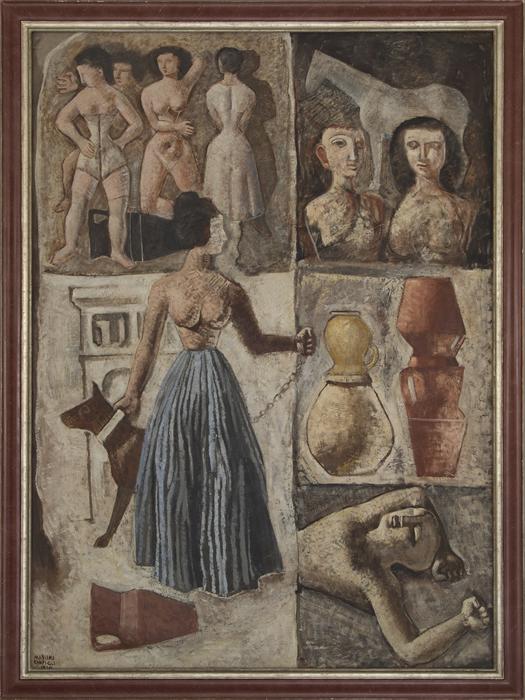Marché des femmes et des pots, 1929
Massimo Campigli (Berlin 1895 – Saint-Tropez 1971
Marché des femmes et des pots
oil on canvas
1929
cm 220 x 160
Massimo Campigli, pseudonym of Max Ihlenfeld, moves to Milan in 1909. From there, in 1914 he is hired by Corriere della Sera and he is drawn into the Futurists, meeting Umberto Boccioni and Carlo Carrà. In 1919, he relocates to Paris. He spends nine years as the correspondent for the Milanese newspaper, whilst at the same time starting to paint.
His first solo exhibition takes place in 1923 at the Galleria Bragaglia in Rome.
In 1927, Massimo Campigli, by now able to make a living from his artistic pursuits, leaves his job at Corriere della Sera to dedicate himself full-time to painting, participating in exhibitions in Paris, Zurich, Dresden, Hamburg and Amsterdam. Together with Giorgio De Chirico, Mario Tozzi, Gino Severini, Filippo De Pisis, Renato Paresce and Alberto Savinio, they form a group known as “I sette di Parigi” [The Paris Seven] or “Italiens de Paris”, which lasted until 1932.
In 1928, he visits Italy and develops a fascination with Etruscan art. Impressed by the ancient frescoes, the painter changes his painting style, bringing his technique closer to that utilised in fresco painting, employing fewer colours and representing people and objects in geometric form. Campigli’s artistic journey leads him to repudiate his previous artistic ventures, which he himself would define “contradictory attempts”, eventually going so far as to repaint his old canvases.
In 1929, Campigli holds an exhibition at the Jeanne Boucher Gallery, a hub for the greatest artists of the age, which secures his international status and success.
It is here that Marché de femmes et de pots “Market of Women and Pots”is exhibited. The woman holding a dog on a lead has the same sculpted geometry and elegance as the vases that surround her in the adjoining space: it is a study in natural simplicity that brings the figures to life, translated through the Etruscan code in stylistic flourishes that are never rigid. The woman with the dog is a “prison warden”: in the imagination of the painter, who envisioned the little sculptures like prisoners in their display cases, the figures that surround her, sealed in their compartments, are like prisoners, “slaves”. Indeed, Campigli gave this painting of his also another title: Mercato di schiave [“The Slave Market”].
Over the following years, he continues to produce and export his art to some of the most important cities in the art world.
In the 1930s, he returns and settles in Milan. There, in 1933, together with De Chirico, Achille Funi and Mario Sironi, he paints murals (later destroyed) for the Palazzo dell’Arte: this was to be the first of many mural projects.
Also an active graphic designer, he illustrates numerous books, among them Marco Polo’s Il Milione.
He also writes several texts in the critique-autobiography genres.
An insatiable traveller, in 1958 Campigli is honoured as a Commendatore al Merito della Repubblica Italiana [“Commander of the Order of Merit of the Italian Republic”]. This is followed by various solo exhibitions in Venice, Munich, Melbourne, Sydney and Paris.
Already a veteran academic at the Royal Academy of Belgium, in 1965 he is nominated and welcomed as a member of the Accademia di San Luca in Rome.
His success is already guaranteed, with exhibitions around the world and his works on display at the most famous international festivals and fairs.
